Establishment of the order
During his continued expansion of power, Napoleon Bonaparte conquered Italy in much the same manner as Charlemagne. As a symbolic gesture, he had himself crowned as King of Italy using the Iron Crown of Lombardy for the coronation, which occurred on 26 May 1805.
Soon after, Napoleon founded the Order of the Iron Crown on 5 June 1805. The order was divided into three classes, with an allowance of up to 20 grand cross knights, 100 commander knights, and 500 ordinary knights.
With the eventual end of the Napoleonic Kingdom of Italy, the original order ceased to exist. However, the Emperor of Austria, Francis I, re-established the order in 1815 as the Austrian Imperial Order of the Iron Crown.
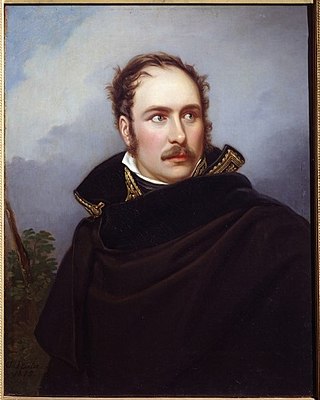
Eugène Rose de Beauharnais was a French nobleman, statesman, and military commander who served during the French Revolutionary Wars and the Napoleonic Wars.

Monza is a city and comune on the River Lambro, a tributary of the Po in the Lombardy region of Italy, about 20 kilometres north-northeast of Milan. It is the capital of the Province of Monza and Brianza. Monza is best known for its Grand Prix motor racing circuit, the Autodromo Nazionale di Monza, which hosts the Formula One Italian Grand Prix with a massive Italian support tifosi for the Ferrari team.

A crown is a traditional form of head adornment, or hat, worn by monarchs as a symbol of their power and dignity. A crown is often, by extension, a symbol of the monarch's government or items endorsed by it. The word itself is used, particularly in Commonwealth countries, as an abstract name for the monarchy itself, as distinct from the individual who inhabits it. A specific type of crown is employed in heraldry under strict rules. Indeed, some monarchies never had a physical crown, just a heraldic representation, as in the constitutional kingdom of Belgium.
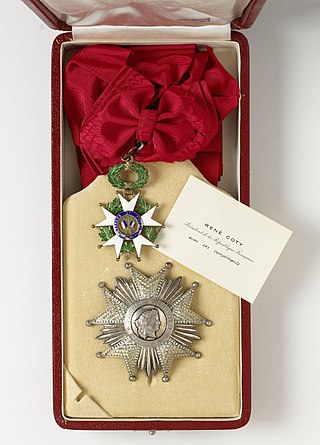
The National Order of the Legion of Honour, formerly the Royal Order of the Legion of Honour, is the highest French order of merit, both military and civil. Established in 1802 by Napoleon Bonaparte, it has been retained by all later French governments and regimes.

The Iron Crown is a relic and may be one of the oldest royal insignia of Christendom. It was made in the Early Middle Ages, consisting of a circlet of gold and jewels fitted around a central silver band, which tradition held to be made of iron beaten out of a nail of the True Cross. In the medieval Kingdom of Italy, the crown came to be seen as a relic from the Kingdom of the Lombards and was used as regalia for the coronation of the Holy Roman Emperors as kings of Italy. It is kept in the Duomo of Monza.

King of Italy was the title given to the ruler of the Kingdom of Italy after the fall of the Western Roman Empire. The first to take the title was Odoacer, a barbarian military leader, in the late 5th century, followed by the Ostrogothic kings up to the mid-6th century. With the Frankish conquest of Italy in the 8th century, the Carolingians assumed the title, which was maintained by subsequent Holy Roman Emperors throughout the Middle Ages. The last Emperor to claim the title was Charles V in the 16th century. During this period, the holders of the title were crowned with the Iron Crown of Lombardy.
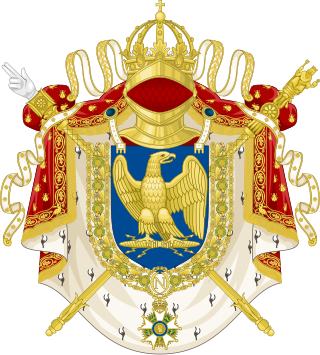
Emperor of the French was the title of the monarch and supreme ruler of the First and the Second French Empires.

The Kingdom of Lombardy–Venetia, commonly called the "Lombardo-Venetian Kingdom", was a constituent land of the Austrian Empire from 1815 to 1866. It was created in 1815 by resolution of the Congress of Vienna in recognition of the Austrian House of Habsburg-Lorraine's rights to the former Duchy of Milan and the former Republic of Venice after the Napoleonic Kingdom of Italy, proclaimed in 1805, had collapsed.

The Kingdom of Italy was a kingdom in Northern Italy in personal union with Napoleon I's French Empire. It was fully influenced by revolutionary France and ended with Napoleon's defeat and fall. Its government was assumed by Napoleon as King of Italy and the viceroyalty delegated to his stepson Eugène de Beauharnais. It covered some of Piedmont and the modern regions of Lombardy, Veneto, Emilia-Romagna, Friuli Venezia Giulia, Trentino, South Tyrol, and Marche. Napoleon I also ruled the rest of northern and central Italy in the form of Nice, Aosta, Piedmont, Liguria, Tuscany, Umbria, and Lazio, but directly as part of the French Empire, rather than as part of a vassal state.

The Austrian Crown Jewels are the regalia and vestments worn by the Holy Roman Emperor, and later by the Emperor of Austria, during the coronation ceremony and other state functions. The term refers to the following objects: the crowns, sceptres, orbs, swords, rings, crosses, holy relics and royal robes, as well as several other objects connected with the ceremony. The collection dates from the 10th to the 19th centuries, and it reflects more than a thousand years of European history. It is kept in the Imperial Treasury at the Hofburg Palace in Vienna, Austria.

An Imperial Crown is a crown used for the coronation of emperors.

The Kingdom of Italy, also called Imperial Italy, was one of the constituent kingdoms of the Holy Roman Empire, along with the kingdoms of Germany, Bohemia, and Burgundy. It originally comprised large parts of northern and central Italy. Its original capital was Pavia until the 11th century.
The Convention of Mantua was an agreement signed by Eugène de Beauharnais and Heinrich Graf von Bellegarde on 24 April 1814 that returned the territories of the Napoleonic Kingdom of Italy to provisional Austrian rule.

The Order of the Crown of Westphalia was instituted in Paris on 25 December 1809 by King Hieronymus I of Westphalen, better known as Napoleon's brother Jérôme Bonaparte. The motto of the Order was "CHARACTER UND AUFRICHTIGKEIT". At the back stood the words "ERRICHTET DEN XXV DEZEMBER MDCCCIX".

The First French Empire, officially the French Republic, then the French Empire after 1809, also known as Napoleonic France, was the empire ruled by Napoleon Bonaparte, who established French hegemony over much of continental Europe at the beginning of the 19th century. It lasted from 18 May 1804 to 3 May 1814 and again briefly from 20 March 1815 to 7 July 1815.

Napoleon was crowned Emperor of the French on Sunday, December 2, 1804, at Notre-Dame de Paris in Paris. It marked "the instantiation of [the] modern empire" and was a "transparently masterminded piece of modern propaganda".
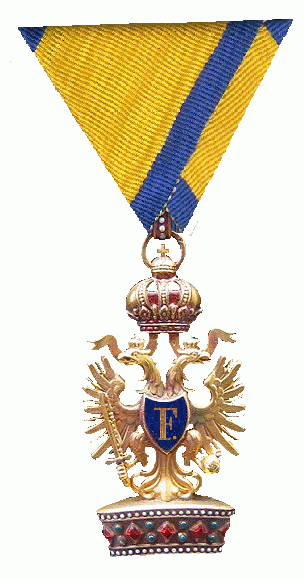
The Imperial Order of the Iron Crown was one of the highest orders of merit in the Austrian Empire and Austria-Hungary until 1918. It was founded in 1815 by Emperor Franz I of Austria as a re-establishment of the original Order of the Iron Crown, which previously had been an order of the Napoleonic Kingdom of Italy.

The monarchy of Italy was the system of government in which a hereditary constitutional monarch was the sovereign of the Kingdom of Italy from 1861 to 1946.
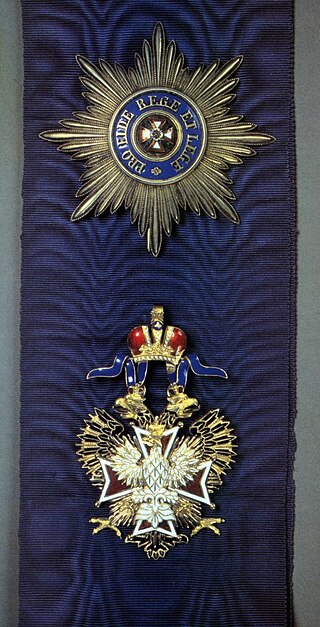
The Imperial Order of the White Eagle was an Imperial Russian Order based on the Polish honor. Emperor Nicholas I of Russia established the award in 1831 as the Imperial and Royal Order of the White Eagle. A recipient of the Order was granted the title Knight of the Imperial Order of the White Eagle.
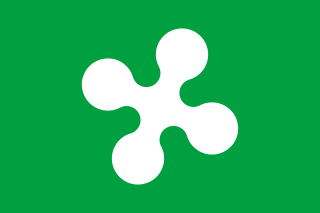
The flag of Lombardy is one of the official symbols of the region of Lombardy, Italy. The current flag was officially adopted on 4 February 2019, although it has been used de facto since 12 June 1975.

























